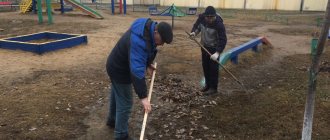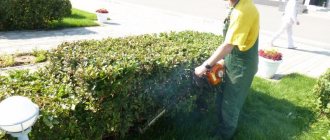Calculation example for a second class territory
- Sweeping snow. Scope of work - 5000 sq.m, number of days per year - 67, frequency of work every 2 hours during snowfall, repeatability throughout the year (Pp) - 810, standard time per unit area (Nvr) - 0.17 min.
Annual time expenditure for the entire scope of work (Zvr/year) - 5000 x 810 x 0.17 = 688500 min.
- Sanding - 5000 sq.m., 20 days a year, 2 times a day, Pp = 40, Nvr = 0.15 min.
Zvr/year = 5000 x 40 x 0.15 = 30000 min.
- Sweeping an area with asphalt pavement – 3000 sq.m., 221 days, 1 time per day, Pp = 221, Nvr = 0.1 min.
Zvr/year = 3000 x 221 x 0.1 = 66300 min.
Total time spent per year on the entire complex of work is 688500 30000 66300 = 784800 min. or 13080 hours.
The required number of janitors = 13080: 1995 x 1.12 = 7 people, where 1995 is the working time of one janitor per year, 1.12 is the absenteeism rate.
Quantity
Legislation to regulate the work of janitors has developed and approved time standards for performing each type of work.
Basically, when preparing the scope of job responsibilities of a janitor, they rely on:
- Order of the State Construction Committee of the Russian Federation dated December 9, 1999 No. 139 “On approval of Recommendations on the standardization of labor for workers involved in the maintenance and repair of housing stock”;
- Resolution of the Ministry of Labor of the Russian Federation dated June 24, 1996 N 38 “On approval of service standards for workers engaged in sanitary maintenance of households”;
- Resolution of the State Construction Committee of the Russian Federation No. 170 dated September 27, 2003 “On approval of the Rules and Standards for the Technical Operation of the Housing Stock.”
The regulations of local self-government regulate not only the general procedure for the maintenance and improvement of the territory of the municipality, but also who should clean the area near a store or catering establishment if they are located in a residential building, whose functions include keeping intra-block passages clean.
Janitor's opening hours
There is chaos going on in our office. In detail - the essence of the matter:
A housekeeping foreman, who has watchmen, cleaners, and janitors under his command, without informing the director of the municipal enterprise “Kommunalnik” that he accepts people (4 people) with a work book into the hostel, although these people work in another organization. Further, these people do not work (because they are not able to perform the functions of their main job and ours at the same time). Instead of being at her workplace and performing the functions of a foreman, she works 2 days a week. 2.5 hours every other day, he runs away from his main job to guard and wash the floors for those “dead souls.” Then she became completely insolent and for 3 months she didn’t wash the floors at all, but forced the residents of the hostel in which the “dead souls” were supposed to work to be on duty.” The foreman took powers of attorney from all the “dead souls” to receive salaries and allegedly received the money herself for “the work completed.” . When we discovered these facts, checks were carried out, the facts were confirmed, but no acts were drawn up (probably due to ignorance of the laws). Statements from residents about these facts were written. The management of the enterprise gave copies of these statements to the foreman, with the requirement to write explanatory notes. She saw who signed these statements, organized a meeting in the dormitory (although this is not in her competence - she should only check the work of the service staff, only the commandant deals with the residents), began to harass the residents of the dormitory, threatened to evict them... etc. e. Residents refused to pay for common areas because... For 3 months, no one washed the floors, the sinks, or cleaned the toilets. They could not stand such dirt and washed and cleaned themselves on their own. The management of the enterprise took photographs confirming that the dirt in general. it's scary how much. It turns out that the master must be prosecuted not only under the Labor Code of the Russian Federation (absence from his workplace (was there for 2 hours every other day - there are no reports either...), but also for crimes related to obtaining material benefits and advantages for oneself, thereby causing material damage harm to the organization (Article 201 of the Criminal Code of the Russian Federation) The foreman is engaged in squabbles, slander against many employees subordinate to her. She is engaged in harassment and threats of dismissal from work if anyone gets in her way. Our management does not move (WHAT SHOULD WE DO?), lawyer (HR department - still a very “Green” young guy. After all, you need an experienced lawyer to understand this matter. Tell me where to file a statement of claim in this case (to the court or to the prosecutor’s office: the prosecutor’s office has an investigator who would conduct an investigation in the office regarding this case) How to correctly draw up a statement, which articles to refer to? Is it possible through the court to compensate for the losses caused by the foreman for 3 months of the organization in this case? Is it really possible that the official will not be punished for such crimes? Answer our questions. The workers are eagerly awaiting your response.
Depending on the season
In winter and summer, the list of janitor jobs, as well as the main tool used for cleaning, differ. Accordingly, different standards for the cleaned area have been established. The size of the area is influenced by weather conditions, type of surface covering, intensity of pedestrian flow and other factors.
We invite you to familiarize yourself with: Sample statement of claim against a mobile operator
Breakdown into groups by traffic intensity:
- when traffic is up to 50 people per hour, it is considered first class;
- with a flow of 50-100 pedestrians - the second;
- if more than 100 people move along the sidewalk per hour - third.
Yard sidewalks belong to the first class. Lawn areas are not included in any classifications and are considered separately during standardization.
It is customary to divide sidewalks by type of coating:
- improved (asphalt concrete, paving stones);
- unimproved (crushed stone, cobblestone);
- areas without coverings.
In winter, the standards for the harvested area are lower than in summer.
The method for calculating cleaning standards for a janitor is to add up the standards for each type of work performed in different periods and divide the working time by the result obtained. This results in the area that a worker must clean while following the technology and performing other auxiliary types of work.
Employers take the time standards for cleaning 1 meter of area in various ways and using different tools, for cleaning one trash can, for taking out one bag of garbage, and so on for each type, from the standards developed by government agencies. If necessary, the management of the organization hiring janitors can develop their own standards by timing the entire cleaning cycle.
Summer standards
The janitor's summer cleaning standards consist of sweeping sidewalks, watering and caring for lawns, removing garbage and solid household waste generated in the entrusted territory.
According to the intensity group, first-class pedestrian paths are swept once every two to three days, the rest are swept once or twice a day.
When calculating the load on a janitor in the summer, the following are taken into account:
- daily cleaning of waste bins with morning rinsing;
- removal of collected waste to containers or garbage bins;
- organizing bulky garbage and waste at a special site;
- collecting fallen leaves and removing them to containers or to a special area;
- watering asphalt in hot weather.
In winter time
The main task of a janitor in winter is to remove ice and snow and sprinkle icy paths with sand or chemicals.
Accordingly, on first-class pedestrian paths, snow removal is carried out once every three days, on the rest - they are removed daily or every other day. When fresh snow falls, cleaning is carried out immediately, regardless of the surface of the sidewalks or the intensity of pedestrian traffic.
We suggest you read: How to draw up a will for an apartment, how much it costs and what documents are needed Law and home
Loose, recently fallen snow in a layer of up to 2 cm is swept with a broom, and over 2 cm is moved using a wide scraper or snow shovel. The winter season and snowfall do not relieve the janitor of the responsibility for collecting garbage, which must be taken into account in winter standards.
GOST R 56195-2014 Housing and communal services and management of apartment buildings
6.3.2 Winter cleaning
The list of work on cleaning the local area during the winter period includes:
— moving and sweeping snow;
The first snow removal and sprinkling with de-icing agents and clean sand is carried out before 7 a.m. or another time, if such a time is established by the local government authorities on whose territory the apartment building is located.
Removal of falling snow begins when the snow cover reaches a height of more than 2 centimeters; if the snow cover height is less than 2 centimeters, then immediately after the end of the snowfall. If there is continuous snowfall throughout the day, at least 2 cycles of “snow removal, sprinkling with de-icing agents and sweeping” must be performed.
We recommend reading: Is it possible to combine two plots into one in SNT
— formation of snow banks with the necessary gaps between them;
In order to preserve green spaces, it is not allowed to pile snow from sidewalks and walkways, mixed with sand and salt, onto lawns, green strips, front gardens and other areas with bushes and trees.
— elimination of slipperiness;
When icy conditions appear, paths and sidewalks are sprinkled with de-icing agents or clean sand. Treatment of the surfaces of sidewalks, paths and internal roads and parking lots with anti-icing materials is carried out in compliance with the rules for their use.
Note - If there is continuous ice on the sidewalks and in order to avoid accidents, it is permitted, as an exception, to sprinkle the sidewalks with a sand-salt mixture, sifted sand, mixed with salt in an amount of no more than 3% by weight of the sand and (or) special anti-icing mixtures. Accumulated residues, sand and (or) de-icing mixtures, are collected and removed in a timely manner.
The standard period for complete elimination of winter slipperiness and completion of snow removal work from the moment the snowfall or blizzard ends should not exceed more than 3 hours.
— removal of snow and snow-ice formations from sidewalks, paths and roads;
First of all, snow is removed near entrances, from sidewalks, pedestrian paths, then from roadways, parking lots and other structures located (available) in the local area. Sidewalks and pedestrian paths must be cleaned as necessary in such a way that pedestrian traffic along them is not disturbed and always be clear of snow to the surface of their surface. All snow from the sidewalks is moved to the roadway tray for subsequent removal.
— cleaning the tray part of internal roads;
— sweeping and removal of soil sediments in the absence of snowfall for a long time from paths, sidewalks, internal roads, parking lots, playgrounds and children's playgrounds and from the sites of other structures located in the local area;
— water drainage;
When the air temperature is above 0° and the snow is melting, timely measures are taken to remove stagnant water on sidewalks and entrances to the local area by draining it into trays and storm drainage grates. If the natural drainage of stagnant water is difficult for some reason, work is determined, measures are developed that are included in the plan or list of works, the completion of which will ensure the drainage of stagnant water.
— cleaning of manhole covers, water supply and sewer wells, including fire hydrants;
Covers of manholes, water supply and sewer wells, including fire hydrants must be completely cleared of snow and ice.
— cleaning roofs and canopies, removing ice, snow and icicles from eaves, balconies and loggias;
Cleaning the roof facing pedestrian areas from snow, ice and icicles should be carried out as they form, with preliminary fencing of dangerous areas and compliance with safety regulations.
In compliance with measures to ensure the safety of people and animals, timely clearing of snow and ice from roofs and canopies is ensured, removal of ice, snow and icicles from eaves, balconies and loggias, ensuring safety measures for branches of tree crowns, cars and other equipment located and passing near at home, including ensuring the safety of wires from damage from falling lumps of snow and ice.
Snow and ice icicles thrown from roofs must be immediately removed from the sidewalk and taken to designated areas.
When cleaning roofs, it is necessary to pay attention to the places of greatest formation of ice and icicles, register them, check the attic in order to determine the places and sources of heat entering the attic and the possibility of lowering the air temperature in the attic by isolating the places of heat entry and (or) organizing ventilation of the attic space or the space between the sheathing and covering material. As a possible option for a comprehensive solution, provide for the possibility of laying a heating cable along the perimeter of the roof in places where icicles are intensively formed.
— removal of snow and snow-ice formations.
Snow removal is carried out to places determined by local authorities, which are previously agreed upon with the contractor. The snow is removed in a loose state, preventing it from compacting or freezing.
12.1 To control property maintenance services, the following methods are used:
— visual control (tracking the timing, volume and frequency of work, the efficiency of the specialists and services of the contractor when performing work, checking the service culture, the equipment used, equipment, checking the availability of technical and other documentation, etc.);
— analytical (analysis of documentation, certificates of work performed, schedules for cleaning the local area, control logs and records of applications, etc.);
— sociological (considering complaints, surveying consumers, questioning, etc.)
— comparative analysis (based on archival documents, photographs, acts, application logs and reports, tracking changes in the technical condition of the property, consumer satisfaction, improvement of living comfort, etc.);
Standardization of work for a janitor in a state organization
By order of the Ministry of Labor of Russia dated September 30, 2013. No. 504 approved a methodology for developing a procedure for standardizing labor in government institutions, which is advisory in nature.
Standards for cleaning the territory for a janitor in a budgetary institution are formed by analyzing federal standard standards.
With their help they determine:
- time standards (time spent on performing a unit of work by one employee);
- maintenance standards - the area that an employee must clean per unit of working time;
- standard number - the number of workers required to perform specific work.
The developed system of labor standardization in a budgetary institution is formalized by the corresponding Regulations, which is included as an independent section in the collective agreement.
What work needs to be done
The work required by a janitor is specified in his job description or in the employment contract. Time periods for carrying out cleaning activities are established so as not to create inconvenience to citizens.
Responsibilities of a janitor for cleaning the local area:
- maintaining the cleanliness of the areas adjacent to the building;
- cleaning sidewalks, removing dust, sand, snow, ice, debris;
- watering sidewalks in the summer and sprinkling sand in the winter;
- keeping fire and storm water wells and drains clean;
- ensuring the safety of plants and grass cover in the entrusted territory;
- maintenance of fences and fences;
- cleaning and washing trash cans;
- cleaning cornices and drainage pipes;
- timely informing management about violations;
- cleaning of children's and sports grounds, if available;
- cleaning areas for garbage containers, assisting in unloading them if necessary.
The list is far from complete and in each specific case can be expanded or reduced by the employer depending on needs and volumes.
Standard for cleaning the area for a janitor
The document that regulates such norms is an order of the Moscow Government. Each organization sets certain standards for its wipers, but all of them must comply with the document mentioned above. This document clearly regulates the cleaning area of the janitor, the size of which depends on certain factors.
Most of us, when leaving the house, see how visiting janitors are cleaning the local area. Garbage is removed from lawns, sidewalks and roadways are swept. The trash cans are being emptied. Mechanized cleaning of road areas is carried out. Special machines collect dirt and dust from the roads and wash them.
Calculation of the number of janitors
- Determine what work they will perform during the year. This is required by the seasonality of work.
- The repeatability of work (taking into account climatic conditions and labor intensity for the year) is calculated according to two indicators: the number of days of the required work for an annual period and the frequency of work on these days.
- According to meteorologists in Moscow, the average number of days without snow, that is, the possible number of days of the work in question in a year, is 221 days. The frequency of sweeping per year (Pp) can be calculated according to the Rules and Standards for the Operation of Residential Buildings.
- Standards for janitors are set depending on the class of the territory, determined by the intensity of human flow.
- I class - up to fifty people/hour - sweeping once every two days. Pp = 221x1 times: 2 = 110 times.
We invite you to read: Warning about changes in the employment contract
II class - from fifty to a hundred people/hour - sweep once a day. Pn = 221 x1 times: 1 day = 221 times.
III class - over a hundred people/hour - sweep twice a day. Pp = 221x2 times: 1 day = 442 times.
The traffic intensity is recorded on the sidewalk (width 0.75 m) according to the maximum load in the morning and evening.
In addition to the gradation by class, the types of surfaces on which cleaning is carried out are also taken into account:
- improved - asphalt, paving slabs;
- unimproved - crushed stone;
- areas without coverage;
- lawns.
Standards for the wage of a dhow janitor
2. Establish that the Standards for determining the number of personnel approved by this Resolution are recommended for use in preschool institutions, regardless of departmental subordination, forms of ownership and management. 3. Ministries, departments, enterprises and organizations, within three months, taking into account the need, submit applications to the Central Bureau of Labor Standards for the publication of Standards for determining the number of personnel approved by this Resolution. The Central Bureau of Labor Standards must ensure the publication of the required number of specified standards.
Establish that, in determining the number of personnel, approved by this Resolution, they are recommended for use in preschool institutions, regardless of departmental subordination, forms of ownership and management.3. Ministries, departments, enterprises and organizations, within three months, taking into account the need to submit applications to the Central Bureau of Labor Standards for publication to determine the number of personnel approved by this Resolution. The Central Bureau of Labor Standards to ensure the publication of the required number of specified standards. Deputy Minister of Labor of the Russian Federation R. BATKAEV Approved by the Resolution of the Ministry of Labor Russia from April 21, 1993
Who controls
The work of the janitor is controlled by an employee of the HOA that hired the employee, the management organization, or a representative chosen by the citizens who own the residential premises of the apartment building. If part of the house is owned by a store, catering outlet, office or service enterprise, then the administration of these establishments is obliged to monitor the cleaning of the adjacent territory.
Control is also exercised by local government bodies and government organizations created to protect the interests of property owners’ rights and environmental protection. In case of non-compliance with the rules for the maintenance and improvement of territories, lack of response to requests from the population, organizations and officials who committed violations are subject to administrative penalties.
Pay level
Employers set wages or payment for janitor services for the scope of work established by the contract and performance of official duties in accordance with standards independently to the best of their financial capabilities.
If the area to be cleaned is smaller or larger, then wages are usually set proportionally. In organizations that apply qualification rules when rationing labor and setting wage levels, the pay for janitors is set at the rate of the first category of workers, that is, the lowest level.
To materially stimulate the work of workers involved in cleaning the territory, a bonus system can be used, providing additional remuneration provided that the standards for servicing the entrusted area are met.
Job description
Nothing is limited to one contract, and the janitor is necessarily given a job description, which he must sign. This document is needed in order to clearly understand what a janitor should do and what not. Having this document in hand, he will no longer do anything for a salary that is not specified in it. Any work that is not in the job description is paid separately.
The job description is initiated and drawn up by a personnel specialist or the HOA board, and then provided to the employee for review.
The job description contains the following points:
- requirements for a janitor;
- his duties;
- his rights;
- responsibility, the equipment that was handed to the specialist and for which he is responsible is immediately registered;
- information about wages;
- information about working conditions;
- information about the rest time due to the employee;
- final provisions;
- signatures of the parties.
Changes to job descriptions are initiated by the board of the HOA, brought to the attention of the employee no later than a month before their introduction, and if the janitor agrees, then either an additional agreement is concluded to the current instructions, or a new document is drawn up, which is also signed by the parties.
You will find general information about the structure and content of job descriptions and employment contracts for HOA employees in a separate article.








